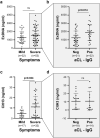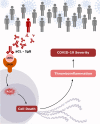Anti-cardiolipin IgG autoantibodies associate with circulating extracellular DNA in severe COVID-19
- PMID: 35869087
- PMCID: PMC9305055
- DOI: 10.1038/s41598-022-15969-y
Anti-cardiolipin IgG autoantibodies associate with circulating extracellular DNA in severe COVID-19
Abstract
Whereas the detection of antiphospholipid autoantibodies (aPL) in COVID-19 is of increasing interest, their role is still unclear. We analyzed a large aPL panel in 157 patients with COVID-19 according to the disease severity. We also investigated a potential association between aPL and extracellular DNA (exDNA, n = 85) or circulating markers of neutrophil extracellular traps (NET) such as citrullinated histones H3 (CitH3, n = 49). A total of 157 sera of patients infected by SARS-CoV-2 were collected. A large aPL panel including lupus anticoagulant, anti-cardiolipin and anti-beta-2 glycoprotein I (IgG, IgM and IgA), anti-phosphatidylethanolamine IgA, anti-prothrombin (IgG and IgM) was retrospectively analyzed according to the disease severity. We found a total aPL prevalence of 54.8% with almost half of the cases having aCL IgG. Within an extended panel of aPL, only aCL IgG were associated with COVID-19 severity. Additionally, severe patients displayed higher CitH3 levels than mild patients. Interestingly, we highlighted a significant association between the levels of aCL IgG and exDNA only in aCL positive patients with severe disease. In conclusion, we showed a significant link between aPL, namely aCL IgG, and circulating exDNA in patients with severe form of COVID-19, that could exacerbate the thrombo-inflammatory state related to disease severity.
© 2022. The Author(s).
Conflict of interest statement
The authors declare no competing interests.
Figures




Similar articles
-
Frequency of positive antiphospholipid antibodies in pregnant women with SARS-CoV-2 infection and impact on pregnancy outcome: A single-center prospective study on 151 pregnancies.Front Immunol. 2022 Sep 15;13:953043. doi: 10.3389/fimmu.2022.953043. eCollection 2022. Front Immunol. 2022. PMID: 36189273 Free PMC article.
-
Antiphospholipid antibodies are enriched post-acute COVID-19 but do not modulate the thrombotic risk.Clin Immunol. 2023 Dec;257:109845. doi: 10.1016/j.clim.2023.109845. Epub 2023 Nov 22. Clin Immunol. 2023. PMID: 37995947
-
Frequency and clinical correlates of antiphospholipid antibodies arising in patients with SARS-CoV-2 infection: findings from a multicentre study on 122 cases.Clin Exp Rheumatol. 2020 Jul-Aug;38(4):754-759. Epub 2020 Jul 28. Clin Exp Rheumatol. 2020. PMID: 32723434
-
Systematic Review of Antiphospholipid Antibodies in COVID-19 Patients: Culprits or Bystanders?Curr Rheumatol Rep. 2021 Jul 3;23(8):65. doi: 10.1007/s11926-021-01029-3. Curr Rheumatol Rep. 2021. PMID: 34218350 Free PMC article.
-
COVID-19 and Antiphospholipid Antibodies: Time for a Reality Check?Semin Thromb Hemost. 2022 Feb;48(1):72-92. doi: 10.1055/s-0041-1728832. Epub 2021 Jun 15. Semin Thromb Hemost. 2022. PMID: 34130340 Review.
Cited by
-
Severe COVID-19 patients exhibit elevated levels of autoantibodies targeting cardiolipin and platelet glycoprotein with age: a systems biology approach.NPJ Aging. 2023 Aug 24;9(1):21. doi: 10.1038/s41514-023-00118-0. NPJ Aging. 2023. PMID: 37620330 Free PMC article.
-
The Diagnostic, Prognostic, and Therapeutic Potential of Cell-Free DNA with a Special Focus on COVID-19 and Other Viral Infections.Int J Mol Sci. 2023 Sep 15;24(18):14163. doi: 10.3390/ijms241814163. Int J Mol Sci. 2023. PMID: 37762464 Free PMC article. Review.
-
COVID-19 induced liver injury from a new perspective: Mitochondria.Mitochondrion. 2023 May;70:103-110. doi: 10.1016/j.mito.2023.04.001. Epub 2023 Apr 11. Mitochondrion. 2023. PMID: 37054906 Free PMC article. Review.
-
Factors associated with immune responses to SARS-CoV-2 vaccination in individuals with autoimmune diseases.JCI Insight. 2024 Jun 4;9(13):e180750. doi: 10.1172/jci.insight.180750. JCI Insight. 2024. PMID: 38833310 Free PMC article.
-
COVID-19 and antiphospholipid antibodies.Best Pract Res Clin Haematol. 2022 Sep;35(3):101402. doi: 10.1016/j.beha.2022.101402. Epub 2022 Oct 15. Best Pract Res Clin Haematol. 2022. PMID: 36494152 Free PMC article. Review.
References
-
- Lin YS, Lin CF, Fang YT, Kuo YM, Liao PC, Yeh TM, et al. Antibody to severe acute respiratory syndrome (SARS)-associated coronavirus spike protein domain 2 cross-reacts with lung epithelial cells and causes cytotoxicity. Clin. Exp. Immunol. 2005;141(3):500–508. doi: 10.1111/j.1365-2249.2005.02864.x. - DOI - PMC - PubMed
MeSH terms
Substances
LinkOut - more resources
Full Text Sources
Medical
Miscellaneous

